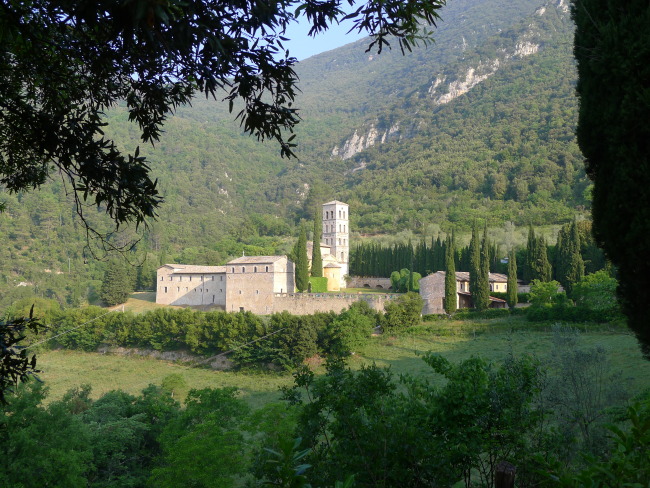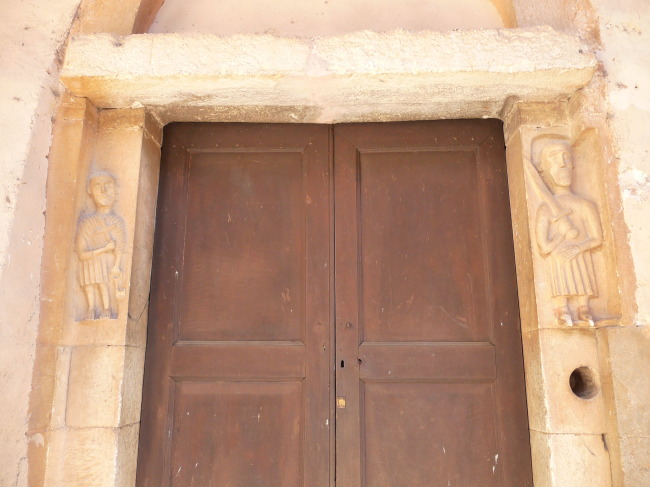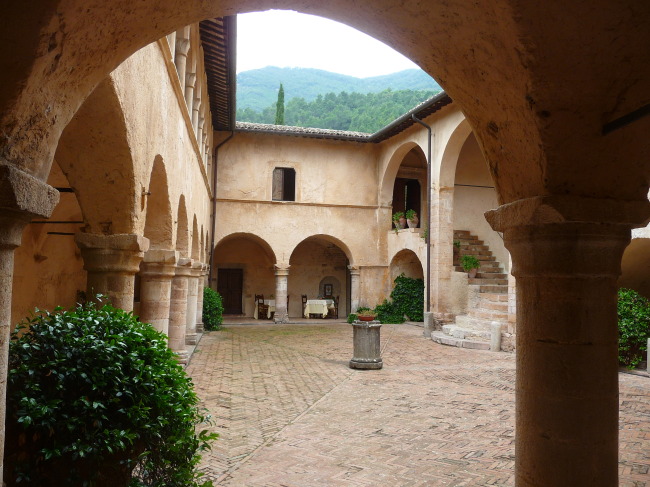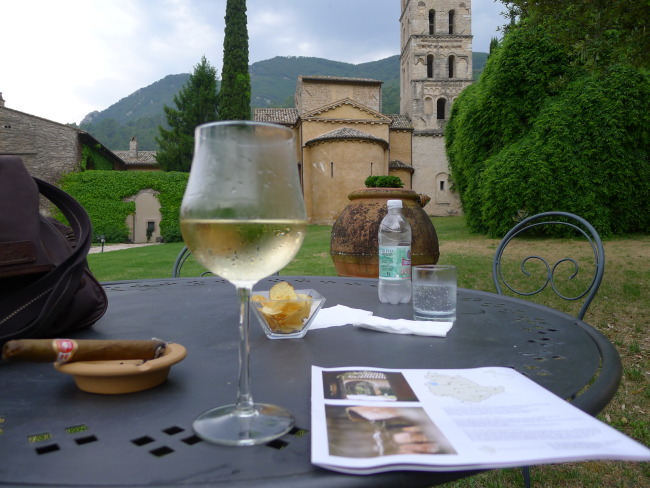Actually, it is now a small hotel in the Valnerina (the Nera Valley in the Appennines). We stayed here last week. There is a cross hanging over every bed, and the rooms are (converted) monks' rooms (Yes, each room or suite has a bath). This is the Abazzia San Pietro in Valle. It began as a Benedictine monastery in the 5th C., established by converted Lombard invaders, the lords of Spoleto.
In fact, the Lombard Lord of Spoleto gave up his lordship to become one of the early humble monks there, and his bones rest in an old (recycled) and beautifully-carved pagan Roman sarcophagus next to the altar. I guess they threw out some old Roman's bones to make room for him.
Their chiesa is old, but, like most things in Italy that have been around for over a thousand years, things have been re-done and re-decorated. We were told that the cheisa, in some places, has five layers of frescoes on the walls. Sort of like old wallpaper, but, as Mrs. BD observed, any one of those layers would make for a blockbuster show at the Metropolitan Museum of Art.
This wealthy and politically-powerful monastery was sacked by the Saracens - the marauding Moslems who held parts of Europe in terror for hundreds of years during the Dark Ages, and who specialized in collecting infidels for the Middle Eastern slave trade - around the year 900, but it came back. It was abandoned by the Benedictines in the 1800s and was used as stables and sheep shelters until some rich guy from Rome bought it in the 1920s and began semi-converting it into his country villa. Mussolini himself visited the Abazzia to celebrate the restoration of Italian history and culture.
One of the most photogenic places I have ever been to. Impossible for even a lousy pic-taker like me to take a bad photo. Felt unreal to be staying there, stunned by the romance of history but mainly by the beauty and glory of creation, just like when you are on a horse in the Montana Rockies, or on skis at the top of Whistler in a snowstorm. The times when the glory of God gets so much in your face you cannot deny it no matter how much of a curmudgeon you might want to be.
See what I mean about Mrs. BD being a good trip-planner? She plans, I just do the driving and go where I am told - except when I don't... More pics from around there later in my ongoing travelogue.
This is inside the walls, in the garden, facing the inner cloisters and the rear of the chiesa with its bell tower:

View from the long, steep dirt entry road, lined with small farms and olive groves. The place is halfway up the mountain. Everywhere, the tinkling of sheep bells, the occasional barking of the sheep dogs, and the crazy horn-like braying of mules. (I don't know why they keep mules, but I do know they make a popular sausage out of them, called "Mulo." Not kidding.)

Lombard-era carvings of Peter and Paul (with the sword) at the monk's side entrance to their chiesa from the inner cloister. You could write a thesis on these "paleo-Christian" things if you wanted to:

Who was staying here? A group of jolly Aussies, and two delightful Dutch couples. The rest were from Rome on getaways with wives or girlfriends. (We had a good chat with a Roman fellow, a young 30s internet entrepreneur, who was there with his dazzling and seductive-looking fiance. They have a 4 year-old daughter. They were planning their honeymoon trip to NYC, San Francisco, and then Kauai, and wanted names of good NYC restaurants and shows to see. What a world! Except for their paranoia, the Italians can teach us all how to really live.)
As I said to Mrs. BD, this ain't no Motel 6. The have only around 12 rooms and suites. The inner cloister, with a couple of outside breakfast tables:

Monks loved their wines. That's my refreshing post-mountain-hiking, pre-dinner Orvieto - the classic white wine of Umbria:



My rather good post about our visit to Norcia showed a road sign to Cascia. We did not visit Cascia, but friendly folks at our Abbazia hotel later informed us that St. Rita is the saint of hopeless causes. I thought to myself, Hmmm. Maybe a saint for Ma
Tracked: Jun 18, 13:59
Here's a fine Umbrian meal we were served (and split between us) in the dining room at the Abbazia, all with a hearty 2006 Sagrantino: Fava Bean and Pecorino Puree Stringozzi Ciriola alla Noriona (their sauce of sausage, black truffle, and
Tracked: Jun 20, 19:20